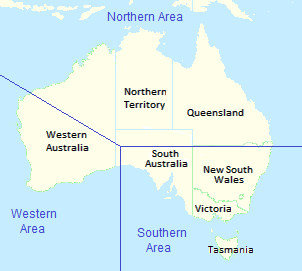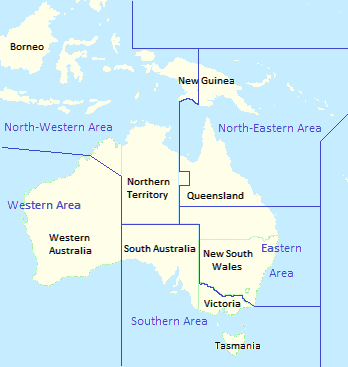Northern Area Command (RAAF) on:
[Wikipedia]
[Google]
[Amazon]
Northern Area Command was one of several geographically based commands raised by the
 Prior to World War II, the
Prior to World War II, the
''Royal Australian Air Force'', pp. 91–92
/ref> The roles of these area commands were air defence, protection of adjacent sea lanes, and aerial reconnaissance. Each was led by an Air Officer Commanding (AOC) responsible for the administration and operations of air bases and units within his boundary. Northern Area Command, headquartered in Townsville, Queensland, was formed on 8 May 1941 under the leadership of Air Commodore Frank Lukis. The command controlled units in northern New South Wales, Queensland, the Northern Territory, and Papua. Lukis was thus responsible for air defence along the entire north coast of Australia.Stephens, ''The RAAF in the Southwest Pacific'', pp. 37–38 The main air base in the Northern Territory, RAAF Station Darwin, was augmented by eight satellite bases in the region.Gillison
''Royal Australian Air Force'', p. 126
/ref> Between June and November 1941, Northern Area took the lead in tracking Japanese pearl luggers, whose increased presence off north-western Australia was regarded as "significant" by intelligence services.Gillison
''Royal Australian Air Force'', pp. 133–134
/ref> Central Area was disbanded in August and its responsibilities divided between Northern Area, Southern Area, and the newly formed No. 2 (Training) Group in
''Royal Australian Air Force'', p. 112
/ref> By December 1941, Lukis' frontline strength in the Northern Territory consisted of No. 2 Squadron flying Lockheed Hudsons, No. 12 Squadron flying CAC Wirraways, and No. 13 Squadron flying Hudsons, all based at RAAF Station Darwin.Helson, ''The Forgotten Air Force'', pp. 57–60, 118 When the
By December 1941, Lukis' frontline strength in the Northern Territory consisted of No. 2 Squadron flying Lockheed Hudsons, No. 12 Squadron flying CAC Wirraways, and No. 13 Squadron flying Hudsons, all based at RAAF Station Darwin.Helson, ''The Forgotten Air Force'', pp. 57–60, 118 When the
''Royal Australian Air Force'', pp. 237–238
/ref> Northern Area Command was instructed to "strike at Japanese bases or shipping wherever possible", "obtain such warning as is possible of any attempted southward movements by the Japanese", "keep open the shipping routes through the Coral, Arafura and Timor Seas", and "deny enemy access to Rabaul and to the Territories of New Guinea, Papua and the Mainland of Australia". Nos. 2, 11, 13, 20 and 24 Squadrons undertook reconnaissance, maritime patrol and sporadic bombing missions against Japanese targets in the Dutch East Indies and Torres Strait.Gillison
''Royal Australian Air Force'', pp. 240–242
/ref> Short of modern fighters and sufficient numbers of bombers, the RAAF units were, according to the official history of Australia in the war, "virtually powerless" to either attack or defend against Japanese forces building up in the region.Gillison
''Royal Australian Air Force'', pp. 319–322
/ref> On 15 January 1942, Northern Area was split into North-Western Area and North-Eastern Area, to counter distinct Japanese threats to LAmbon and Darwin in the former case, and Rabaul and Port Moresby in the latter.Gillison
''Royal Australian Air Force'', p. 311
/ref> Lukis remained at Townsville as AOC of the new North-Eastern Area Command.Ashworth, ''How Not to Run an Air Force'', pp. 302–304 North-Western Area Command was headquartered at
Royal Australian Air Force
"Through Adversity to the Stars"
, colours =
, colours_label =
, march =
, mascot =
, anniversaries = RAAF Anniversary Commemoration ...
(RAAF) during World War II. It was formed in May 1941, and covered the whole of northern Australia and Papua. Headquartered at Townsville, Queensland, Northern Area Command was responsible for air defence, aerial reconnaissance and protection of the sea lanes within its boundaries. In January 1942, following the outbreak of the Pacific War
The Pacific War, sometimes called the Asia–Pacific War, was the theater of World War II that was fought in Asia, the Pacific Ocean, the Indian Ocean, and Oceania. It was geographically the largest theater of the war, including the vast ...
, it was divided into North-Western and North-Eastern Area Commands, to counter Japanese threats to northern Australia and Papua, respectively.
History
 Prior to World War II, the
Prior to World War II, the Royal Australian Air Force
"Through Adversity to the Stars"
, colours =
, colours_label =
, march =
, mascot =
, anniversaries = RAAF Anniversary Commemoration ...
was small enough for all its elements to be directly controlled by RAAF Headquarters in Melbourne. After war broke out, the RAAF began to decentralise its command structure, commensurate with expected increases in manpower and units.Stephens, ''The Royal Australian Air Force'', pp. 111–112 Between March 1940 and May 1941, it divided Australia and Papua into four geographically based command-and-control zones: Central Area, Southern Area, Western Area, and Northern Area.Gillison''Royal Australian Air Force'', pp. 91–92
/ref> The roles of these area commands were air defence, protection of adjacent sea lanes, and aerial reconnaissance. Each was led by an Air Officer Commanding (AOC) responsible for the administration and operations of air bases and units within his boundary. Northern Area Command, headquartered in Townsville, Queensland, was formed on 8 May 1941 under the leadership of Air Commodore Frank Lukis. The command controlled units in northern New South Wales, Queensland, the Northern Territory, and Papua. Lukis was thus responsible for air defence along the entire north coast of Australia.Stephens, ''The RAAF in the Southwest Pacific'', pp. 37–38 The main air base in the Northern Territory, RAAF Station Darwin, was augmented by eight satellite bases in the region.Gillison
''Royal Australian Air Force'', p. 126
/ref> Between June and November 1941, Northern Area took the lead in tracking Japanese pearl luggers, whose increased presence off north-western Australia was regarded as "significant" by intelligence services.Gillison
''Royal Australian Air Force'', pp. 133–134
/ref> Central Area was disbanded in August and its responsibilities divided between Northern Area, Southern Area, and the newly formed No. 2 (Training) Group in
Sydney
Sydney ( ) is the capital city of the state of New South Wales, and the most populous city in both Australia and Oceania. Located on Australia's east coast, the metropolis surrounds Sydney Harbour and extends about towards the Blue Mountain ...
.Gillison''Royal Australian Air Force'', p. 112
/ref>
 By December 1941, Lukis' frontline strength in the Northern Territory consisted of No. 2 Squadron flying Lockheed Hudsons, No. 12 Squadron flying CAC Wirraways, and No. 13 Squadron flying Hudsons, all based at RAAF Station Darwin.Helson, ''The Forgotten Air Force'', pp. 57–60, 118 When the
By December 1941, Lukis' frontline strength in the Northern Territory consisted of No. 2 Squadron flying Lockheed Hudsons, No. 12 Squadron flying CAC Wirraways, and No. 13 Squadron flying Hudsons, all based at RAAF Station Darwin.Helson, ''The Forgotten Air Force'', pp. 57–60, 118 When the Pacific War
The Pacific War, sometimes called the Asia–Pacific War, was the theater of World War II that was fought in Asia, the Pacific Ocean, the Indian Ocean, and Oceania. It was geographically the largest theater of the war, including the vast ...
broke out, Nos. 2 and 13 Squadrons deployed forces to advanced operational bases at Koepang, Laha and Namlea in the Dutch East Indies
The Dutch East Indies, also known as the Netherlands East Indies ( nl, Nederlands(ch)-Indië; ), was a Dutch colony consisting of what is now Indonesia. It was formed from the nationalised trading posts of the Dutch East India Company, which ...
. Nos. 11 and 20 Squadrons, flying PBY Catalinas
The Consolidated PBY Catalina is a flying boat and amphibious aircraft that was produced in the 1930s and 1940s. In Canadian service it was known as the Canso. It was one of the most widely used seaplanes of World War II. Catalinas served wi ...
, were based at Port Moresby in Papua and No. 24 Squadron, flying Hudsons and Wirraways, at Rabaul
Rabaul () is a township in the East New Britain province of Papua New Guinea, on the island of New Britain. It lies about 600 kilometres to the east of the island of New Guinea. Rabaul was the provincial capital and most important settlement in ...
in New Britain.Gillison''Royal Australian Air Force'', pp. 237–238
/ref> Northern Area Command was instructed to "strike at Japanese bases or shipping wherever possible", "obtain such warning as is possible of any attempted southward movements by the Japanese", "keep open the shipping routes through the Coral, Arafura and Timor Seas", and "deny enemy access to Rabaul and to the Territories of New Guinea, Papua and the Mainland of Australia". Nos. 2, 11, 13, 20 and 24 Squadrons undertook reconnaissance, maritime patrol and sporadic bombing missions against Japanese targets in the Dutch East Indies and Torres Strait.Gillison
''Royal Australian Air Force'', pp. 240–242
/ref> Short of modern fighters and sufficient numbers of bombers, the RAAF units were, according to the official history of Australia in the war, "virtually powerless" to either attack or defend against Japanese forces building up in the region.Gillison
''Royal Australian Air Force'', pp. 319–322
/ref> On 15 January 1942, Northern Area was split into North-Western Area and North-Eastern Area, to counter distinct Japanese threats to LAmbon and Darwin in the former case, and Rabaul and Port Moresby in the latter.Gillison
''Royal Australian Air Force'', p. 311
/ref> Lukis remained at Townsville as AOC of the new North-Eastern Area Command.Ashworth, ''How Not to Run an Air Force'', pp. 302–304 North-Western Area Command was headquartered at
Darwin
Darwin may refer to:
Common meanings
* Charles Darwin (1809–1882), English naturalist and writer, best known as the originator of the theory of biological evolution by natural selection
* Darwin, Northern Territory, a territorial capital city i ...
, Northern Territory; its inaugural AOC was Air Commodore Douglas Wilson.

Aftermath
Following the end of the war, the Chief of the Air Staff, Air Vice Marshal George Jones, proposed reducing the five extant mainland area commands (North-Western, North-Eastern, Eastern, Southern, and Western Areas) to three. One of these would have been Northern Area, covering Queensland and the Northern Territory. The Australian Government rejected the plan and the wartime area command boundaries essentially remained in place until supplanted in 1953–54 by a functional command-and-control system made up ofHome
A home, or domicile, is a space used as a permanent or semi-permanent residence for one or many humans, and sometimes various companion animals. It is a fully or semi sheltered space and can have both interior and exterior aspects to it. H ...
(operational), Training, and Maintenance Commands.Stephens, ''Going Solo'', p. 68
Notes
References
* * * * * * * {{RAAF area commandsNorthern
Northern may refer to the following:
Geography
* North, a point in direction
* Northern Europe, the northern part or region of Europe
* Northern Highland, a region of Wisconsin, United States
* Northern Province, Sri Lanka
* Northern Range, a ra ...
Military units and formations established in 1941
Military units and formations disestablished in 1942
RAAF commands